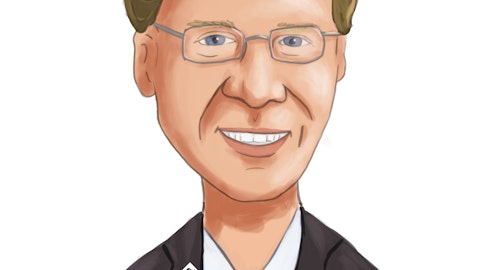Kent Yee: Yeah. I mean at the high level what starts off really supporting that is our gross margins. If you look at our gross margins over the past 1.5 years, two years, we’ve taken a step up by about 100 to 200 basis points call it on average. So that 29% to 30% gross profit range is the biggest driver. And then as is inherent in distribution you get SG&A leverage. And so if you’re managing costs correctly, which we work pretty hard on if you get to 30% and then you’ve got the 20% SG&A, which has been one of David’s long-term goals you get to the 10%. And so we’ve been able to do that. Part of that is driven by mix. Once again our water/wastewater acquisitions tend to perform at a higher level of gross margin. So does our air compressors.
And then our base business we’re always pushing our heritage if you will DXP business to perform in line with those businesses and get to that 30%. And we surely have some that do that and more. So those are the levers at a high level and we’ve been experiencing that quarter-over-quarter.
Thomas Moll: All right. Kent on interest expense, I just want to make sure I heard everything you said correctly and there’s a couple of layers here. So maybe we’ll start with the easier one. I think what I heard you say is forgetting about Q4 for a minute where there’s some noise, but that post the refinancing on today’s SOFR it’s about a $16 million to $17 million a quarter expense line. Did I interpret that correctly?
Kent Yee: Yeah, yeah. It’s a floating rate. So it’s a little bit of a moving target Tommy, but that’s correct. If you just, kind of, with everything you know today pro forma it right at about $16 million to $17 million in interest expense a quarter for the new incremental $125 million.
Thomas Moll: Okay. And then 4Q, which will be a little bit trickier there was a $12.4 million item and a $12 million to $13 million item. Can we just go back over those again?
Kent Yee: Yeah. Essentially you have — you already for lack of better words expense and pay for it but due to the accounting you have unamortized debt issuance costs that you write off as part of a new facility and a new transaction. So we’ll write that off and flush that through the P&L if you will in Q4 and then we’ll capitalize a new $12 million to $13 million worth of debt issuance costs associated with the new facility or the new $550 million raised here just recently. So that’s essentially what will go on. The P&L impacts once again that people will see is just the write-off of the debt issuance costs and then you’ll start to see obviously the new pro forma interest kick in, in Q4. So those are the two things you’ll really see in the P&L.
Tommy Moll: Okay. And if you think about the consolidated interest expense line for Q4, what does it all add up to?
Kent Yee: Well, once again also the missing piece which once again as we do in today’s environment, we are managing cash. Meaning, hey, we do get some interest income on our cash that offsets that $16 million to $17 million, but that’s — there’s a daily movement there a little bit. So, net you could get down to $15.5 million at the lower end of that forecast of interest expense is what I would tell you just in terms of what’s rolling through the P&L.
Tommy Moll: And that’s for Q4 or for the run rate?
Kent Yee: Yeah, for Q4. Once again, the facility also amortizes. If you go past Q4, Tommy, 1% per year in terms of principal reduction. So, you’re effectively lowering that ultimate interest over time. Not to get into the details of that math here on the phone. But I think, in Q4 what you would expect to see is the $16 million to $17 million in interest expense. And then as you go forward, every quarter, the combination of debt amortization of the 1% per year or 0.25% every quarter plus kind of some interest income associated with the cash on the balance sheet will offset that. And so, it will peak probably in Q4, Q1 and then it will just lessen as we go out.
Tommy Moll: Okay. Let’s see. On a couple of strategic items for you guys. M&A, I think I heard maybe four to five more deals, you’ve got soft circled for Q4, Q1. What can you tell us about that pipeline, particularly in terms of just size of the deals you’re considering at this point and what seller expectations look like in this rate and economic environment?
Kent Yee: So, we actually have letters of intent in place. So we’re just actively working through due diligence on those and that’s why we said a minimum of four to five by the end of Q1. The timing once again, the calendar is a little bit tough at this time of the year. You have holidays and different things. So we’re kind of working through that being sure we’re being prudent from a due diligence standpoint. But we’re anticipating potentially some here as we close out the year. And obviously, if we don’t hit that timeline, we’ll close them out in the first quarter. So, just to give you some color there. Just in terms of kind of overall expectations from a valuation standpoint, I mean, hey we still continue to find good deals at good multiples.
I mean, our average purchase multiple has always been seven times or less. And so we’re still finding those opportunities out there in the marketplace. The themes in terms of the types of acquisitions water/wastewater continues to be a big theme. We do have some just industrial kind of I’ll call it rotating equipment product in our repair and services. And so, those are also one of our themes. That’s what Alliance Pumping & Mechanical was closer to and did add some water/wastewater things there, but also just some general rotating equipment repair type stuff. So those are the themes we’re seeing. And so we’re kind of excited to work through those and we’ll be excited to kind of report those when we get those closed.


